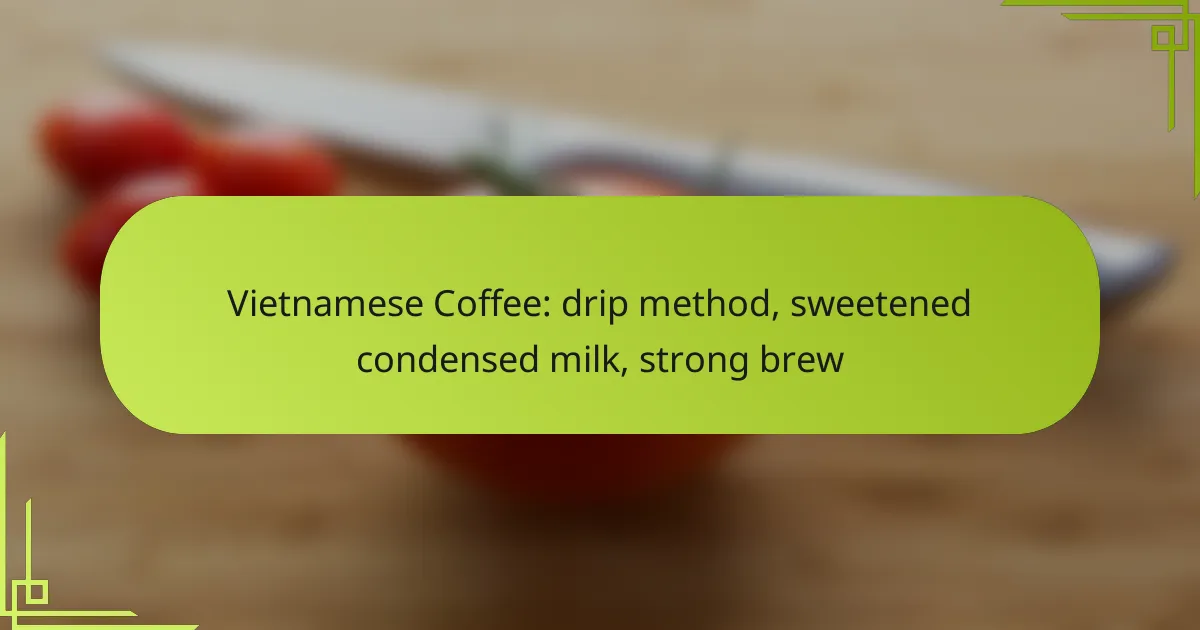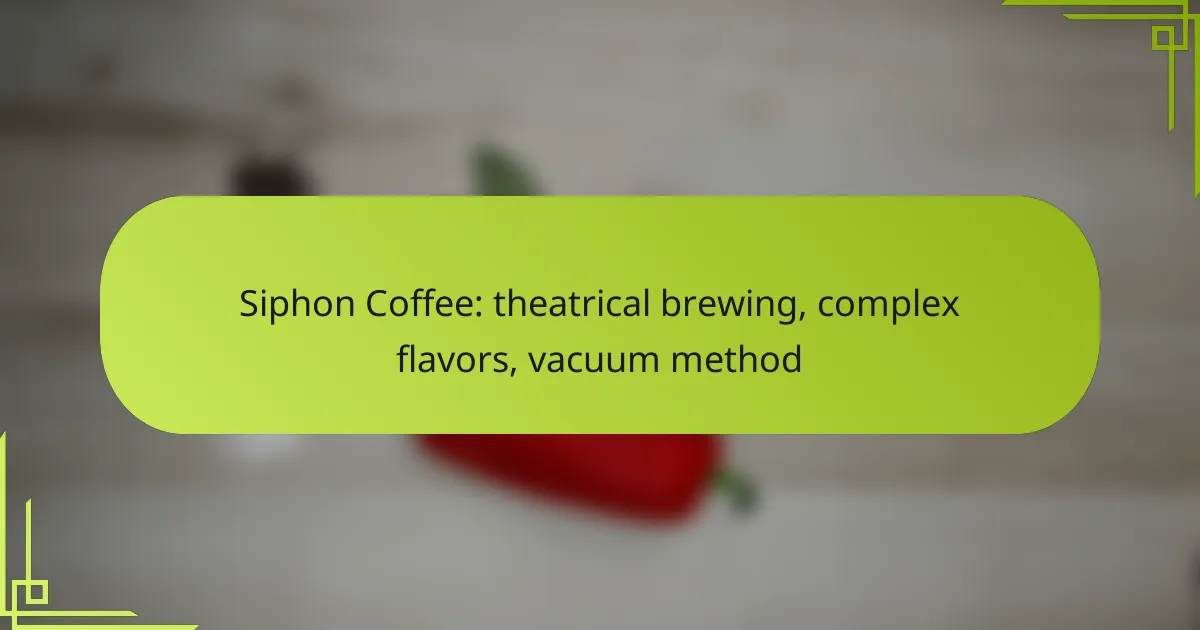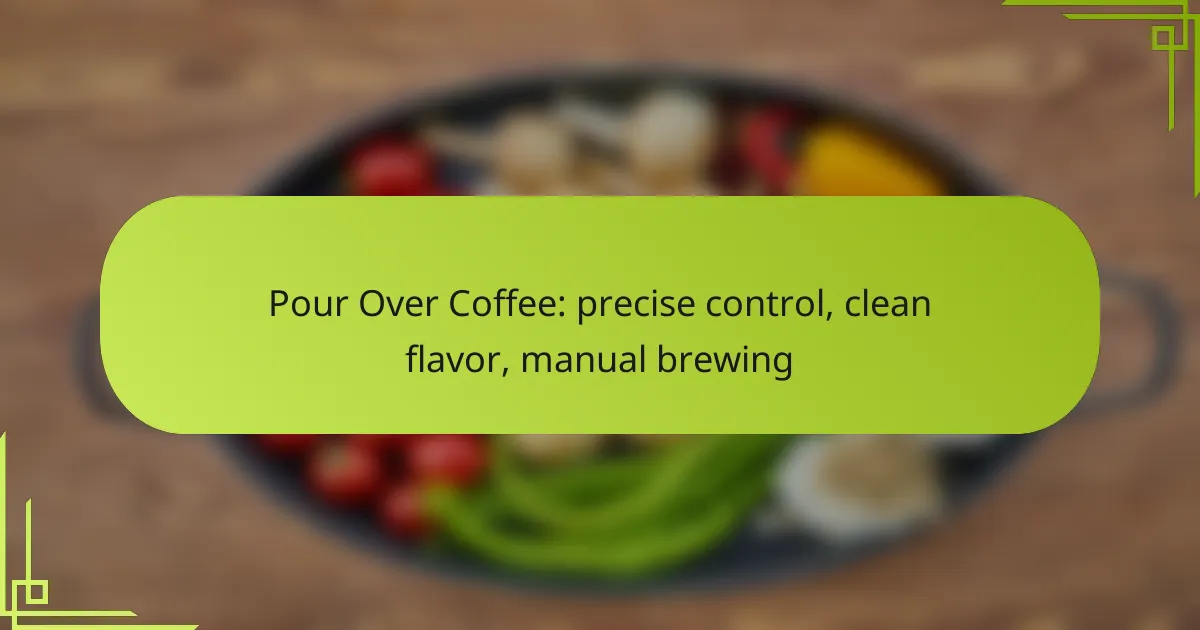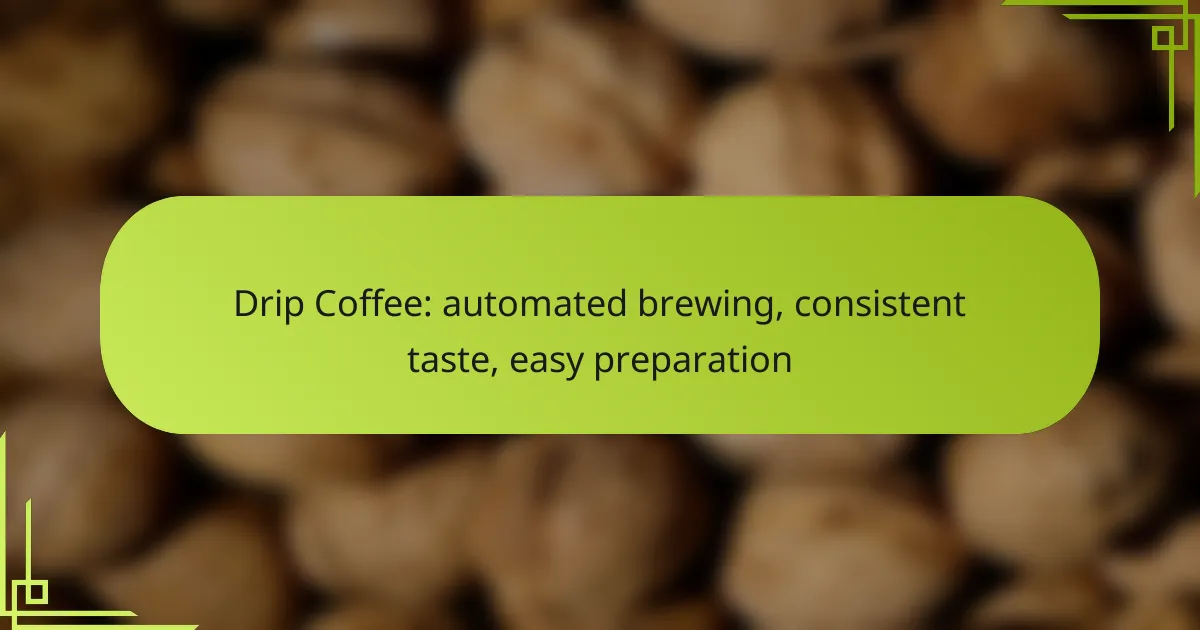Vietnamese coffee is renowned for its strong, bold flavor, achieved through a traditional drip method using a phin filter and robusta coffee beans. This unique brewing technique allows for precise control over water temperature and brewing time, resulting in a rich cup often enhanced with sweetened condensed milk, which adds a delightful creaminess and sweetness. The combination of these elements creates a distinctive coffee experience that stands out in the world of beverages.

How to brew Vietnamese coffee with drip method?
Brewing Vietnamese coffee with the drip method involves using a phin filter, robusta coffee beans, and precise control over water temperature and brewing time. This traditional method results in a strong, flavorful cup of coffee, often sweetened with condensed milk.
Use a traditional phin filter
The phin filter is a small, metal brewing device that allows coffee to drip slowly into a cup. To use it, place the filter over your cup, add ground coffee, and pour hot water over it. The slow dripping process extracts rich flavors from the coffee grounds.
Ensure the filter is clean and properly assembled before use. A common mistake is to pack the coffee too tightly, which can slow down the brewing process excessively. Aim for a medium grind for optimal extraction.
Choose robusta coffee beans
Robusta coffee beans are preferred for brewing Vietnamese coffee due to their strong flavor and higher caffeine content compared to arabica beans. They provide a bold taste that complements the sweetness of condensed milk.
Look for fresh, high-quality robusta beans, ideally sourced from Vietnam. If you’re unsure, consider purchasing from specialty coffee shops that offer single-origin options. Freshly ground beans will enhance the overall flavor profile.
Control water temperature
Water temperature plays a crucial role in brewing Vietnamese coffee. The ideal temperature is typically between 90°C and 95°C (194°F to 203°F). Water that is too hot can scorch the coffee, while cooler water may not extract enough flavor.
Use a thermometer or let boiling water sit for about 30 seconds to reach the right temperature. This step is vital for achieving the rich, robust flavor characteristic of Vietnamese coffee.
Adjust brewing time
The brewing time for Vietnamese coffee generally ranges from 4 to 10 minutes, depending on your taste preference and the grind size. A longer brewing time will yield a stronger cup, while a shorter time will produce a milder flavor.
Monitor the drip process closely. If the coffee drips too slowly, it may indicate that the grind is too fine or the coffee is packed too tightly. Adjust these factors to achieve your desired strength and flavor.
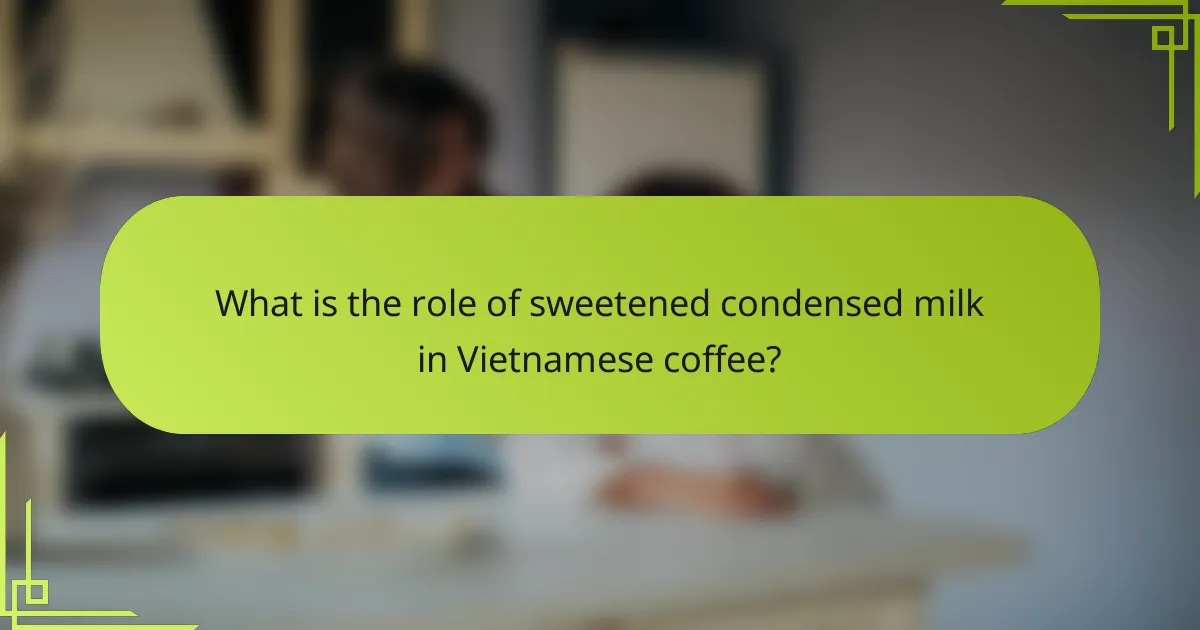
What is the role of sweetened condensed milk in Vietnamese coffee?
Sweetened condensed milk plays a crucial role in Vietnamese coffee by adding sweetness and creaminess to the strong brew. It transforms the coffee into a rich, indulgent beverage that balances the intense flavors of the coffee itself.
Adds sweetness and creaminess
The primary function of sweetened condensed milk in Vietnamese coffee is to provide a sweet and creamy element. This thick milk is made by removing most of the water from regular milk and adding sugar, resulting in a syrupy consistency that enhances the overall flavor profile of the drink.
When combined with the strong brew, the sweetness from the condensed milk offsets the bitterness of the coffee, making it more palatable for those who might find black coffee too harsh. This combination is particularly popular in Vietnam, where coffee is often enjoyed as a dessert-like treat.
Balances the strong coffee flavor
Vietnamese coffee is known for its robust and bold flavor, which can be overwhelming for some. Sweetened condensed milk serves to balance this intensity by softening the coffee’s sharpness, creating a more harmonious taste experience.
This balance is especially important when using dark-roasted coffee beans, which are common in Vietnamese coffee. The milk not only tempers the bitterness but also enhances the natural chocolate and caramel notes found in the coffee.
Enhances texture and richness
In addition to sweetness, sweetened condensed milk contributes a velvety texture to Vietnamese coffee. Its thick consistency adds body to the drink, making it feel more luxurious and satisfying.
This richness is a key characteristic of Vietnamese coffee, setting it apart from other coffee styles. The combination of the creamy milk and strong coffee creates a unique mouthfeel that enhances the overall enjoyment of the beverage.

Why is Vietnamese coffee considered strong?
Vietnamese coffee is considered strong primarily due to its high caffeine content and unique brewing method. The combination of robusta beans and a slow drip process results in a bold, intense flavor profile that distinguishes it from other coffee styles.
High caffeine content from robusta beans
Vietnamese coffee typically uses robusta beans, which contain significantly more caffeine than arabica beans. This higher caffeine content can range from 2.2% to 2.7%, compared to arabica’s 1.2% to 1.5%. The result is a coffee that not only tastes stronger but also provides a more potent energy boost.
Robusta beans are known for their earthy and bitter flavors, which contribute to the overall strength of the brew. This makes Vietnamese coffee particularly appealing to those who prefer a more intense coffee experience.
Brewing method extracts bold flavors
The traditional Vietnamese drip method, known as “phin,” allows for a slow extraction of flavors, enhancing the coffee’s strength. This method involves placing the coffee grounds in a metal filter and allowing hot water to drip through them slowly, typically taking several minutes to brew a cup.
This slow brewing process not only intensifies the flavors but also creates a rich, thick texture. The resulting brew is often enjoyed with sweetened condensed milk, which balances the strong flavors while maintaining the coffee’s robust character.

What are the best brands of Vietnamese coffee?
The best brands of Vietnamese coffee are known for their rich flavors and unique brewing methods. Popular options include Trung Nguyên, Highlands Coffee, and Phúc Long Coffee, each offering distinct characteristics that appeal to coffee enthusiasts.
Trung Nguyên coffee
Trung Nguyên is one of the most recognized Vietnamese coffee brands, celebrated for its strong and aromatic blends. Their coffee is often made from a mix of Arabica and Robusta beans, providing a robust flavor profile that pairs well with sweetened condensed milk.
When brewing Trung Nguyên coffee, consider using a traditional Vietnamese drip filter (phin) for the best results. This method allows the coffee to steep slowly, enhancing its rich taste. Look for their G7 instant coffee for a convenient option without sacrificing flavor.
Highlands Coffee
Highlands Coffee is a popular chain in Vietnam, known for its modern take on traditional coffee. Their blends typically feature a smooth and balanced flavor, making them suitable for various coffee drinks, including iced versions.
For a delightful experience, try their signature Highlands Coffee with sweetened condensed milk. This combination creates a creamy and sweet beverage that highlights the coffee’s natural richness. Their cafes often offer a cozy atmosphere for enjoying coffee with friends.
Phúc Long Coffee
Phúc Long Coffee is renowned for its quality and commitment to sourcing premium beans. The brand offers a range of products, from traditional drip coffee to innovative beverages like fruit-infused coffee drinks.
When selecting Phúc Long, consider their specialty blends, which often feature unique flavor notes. Their coffee is an excellent choice for those who enjoy experimenting with different brewing methods, including the classic Vietnamese phin or even espresso machines.

How to select the right coffee for Vietnamese drip brewing?
To select the right coffee for Vietnamese drip brewing, focus on the type of beans and their roast level. The ideal choice typically involves robusta beans for their strong flavor and body, complemented by the right roast to enhance the brewing process.
Look for robusta vs. arabica blends
Vietnamese coffee is traditionally made with robusta beans, which provide a bold and intense flavor profile. While arabica beans are milder and more aromatic, they lack the strength that robusta offers, making them less suitable for this brewing method.
A blend of robusta and arabica can be a good compromise, offering a balance of strength and flavor complexity. However, for an authentic Vietnamese experience, prioritize robusta beans, which are commonly used in local cafes.
Check roast level for flavor profile
The roast level significantly impacts the flavor of your Vietnamese coffee. A medium to dark roast is preferred, as it enhances the coffee’s natural bitterness and richness, complementing the sweetness of condensed milk.
Light roasts may not provide the desired intensity and can result in a more acidic taste, which is not typical for Vietnamese coffee. When selecting coffee, look for descriptions that mention chocolatey or nutty notes, as these flavors pair well with the brewing method.






